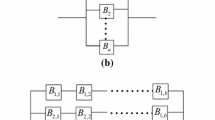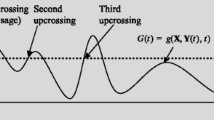Abstract
In this paper, an improved time-variant reliability analysis method based on stochastic process discretization (iTRPD) is proposed. Firstly, the time-variant reliability problem is transformed into a time-invariant series system reliability problem. Then the first order reliability method (FORM) is employed to analyze the reliability of each component of the system, and a corresponding approach is given to calculate the correlation coefficient matrix of all the components’ performance functions. Finally, the target time-variant reliability can be obtained with the reliability index vector and the correlation coefficient matrix of the involved components. In this study, the iTRPD is further applied to the system reliability problems, and hence a corresponding time-variant system reliability analysis method is also developed. Four numerical examples are investigated to demonstrate the effectiveness of the proposed methods.






Similar content being viewed by others
References
Andrieu-Renaud C, Sudret B, Lemaire M (2004) The PHI2 method: a way to compute time-variant reliability. Reliab Eng Syst Saf 84(1):75–86
Ditlevsen O (1986) Duration of visit to critical set by Gaussian process. Probab Eng Mech 1(2):82–93
Elishakoff I, Haftka R, Fang J (1994) Structural design under bounded uncertainty—optimization with anti-optimization. Comput Struct 53(6):1401–1405
Engelund S, Rackwitz R, Lange C (1995) Approximations of first-passage times for differentiable processes based on higher-order threshold crossings. Probab Eng Mech 10(1):53–60
Genz A (1992) Numerical computation of multivariate normal probabilities. J Comput Graph Stat 1(2):141–149
Genz A, Bretz F (2009) Computation of multivariate normal and t probabilities. Springer Science & Business Media, New York
Hagen Ø, Tvedt L (1991) Vector process out-crossing as parallel system sensitivity measure. J Eng Mech 117(10):2201–2220
Hohenbichler M, Rackwitz R (1982) First-order concepts in system reliability. Struct Saf 1(3):177–188
Hu Z, Du X (2013a) Time-dependent reliability analysis with joint upcrossing rates. Struct Multidiscip Optim 48(5):893–907
Hu Z, Du X (2013b) A sampling approach to extreme value distribution for time-dependent reliability analysis. J Mech Des 135(7):071003
Hu Z, Du X (2015) First order reliability method for time-variant problems using series expansions. Struct Multidiscip Optim 51(1):1–21
Hu Z, Mahadevan S (2015) Time-dependent system reliability analysis using random field discretization. J Mech Des 137(10):101404
Hu Z, Li H, Du X, Chandrashekhara K (2013) Simulation-based time-dependent reliability analysis for composite hydrokinetic turbine blades. Struct Multidiscip Optim 47(5):765–781
Jiang C, Huang X, Han X, Zhang D (2014) A time-variant reliability analysis method based on stochastic process discretization. J Mech Des 136(9):091009
Jiang C, Huang X, Wei X, Liu N (2017) A time-variant reliability analysis method for structural systems based on stochastic process discretization. Int J Mech Mater Des 13(2):173–193
Krenk S, Madsen HO, Madsen PH (1983) Stationary and transient response envelopes. J Eng Mech 109(1):263–277
Li J, Chen J-b, Fan W-l (2007) The equivalent extreme-value event and evaluation of the structural system reliability. Struct Saf 29(2):112–131
Liu P-L, Der Kiureghian A (1986) Multivariate distribution models with prescribed marginals and covariances. Probab Eng Mech 1(2):105–112
Low B, Zhang J, Tang WH (2011) Efficient system reliability analysis illustrated for a retaining wall and a soil slope. Comput Geotech 38(2):196–204
Madsen PH, Krenk S (1984) An integral equation method for the first-passage problem in random vibration. J Appl Mech 51(3):674–679
Melchers RE, Beck AT (2017) Structural reliability analysis and prediction. Wiley, Chichester
Rackwitz R (1998) Computational techniques in stationary and non-stationary load combination—a review and some extensions. J Struct Eng 25(1):1–20
Rackwitz R, Flessler B (1978) Structural reliability under combined random load sequences. Comput Struct 9(5):489–494
Rice SO (1944) Mathematical analysis of random noise. Bell Labs Tech J 23(3):282–332
Schall G, Faber M, Rackwitz R (1991) The ergodicity assumption for sea states in the reliability estimation of offshore structures. J Offshore Mech Arct Eng 113(3):241–246
Singh A, Mourelatos Z, Nikolaidis E (2011) Time-dependent reliability of random dynamic systems using time-series modeling and importance sampling. SAE Int J Mater Manuf 4(2011–01-0728):929–946
Sudret B (2008) Analytical derivation of the outcrossing rate in time-variant reliability problems. Struct Infrastruct Eng 4(5):353–362
Wang Z, Wang P (2012) A Nested Extreme Response Surface Approach for Time-Dependent Reliability-Based Design Optimization. J Mech Des 134(12):121007
Wang Z, Mourelatos ZP, Li J, Baseski I, Singh A (2014) Time-dependent reliability of dynamic systems using subset simulation with splitting over a series of correlated time intervals. J Mech Des 136(6):061008
Yang J-N, Shinozuka M (1971) On the first excursion probability in stationary narrow-band random vibration. J Appl Mech 38(4):1017–1022
Acknowledgements
This work is supported by the National Key Research and Development Project of China (2016YFD0701105), the National Science Fund for Distinguished Young Scholars (51725502), and the Science Challenge Project (TZ2018007).
Author information
Authors and Affiliations
Corresponding author
Additional information
Responsible Editor: Xiaoping Du
Publisher’s Note
Springer Nature remains neutral with regard to jurisdictional claims in published maps and institutional affiliations.
Rights and permissions
About this article
Cite this article
Jiang, C., Wei, X.P., Wu, B. et al. An improved TRPD method for time-variant reliability analysis. Struct Multidisc Optim 58, 1935–1946 (2018). https://doi.org/10.1007/s00158-018-2002-7
Received:
Revised:
Accepted:
Published:
Issue Date:
DOI: https://doi.org/10.1007/s00158-018-2002-7




